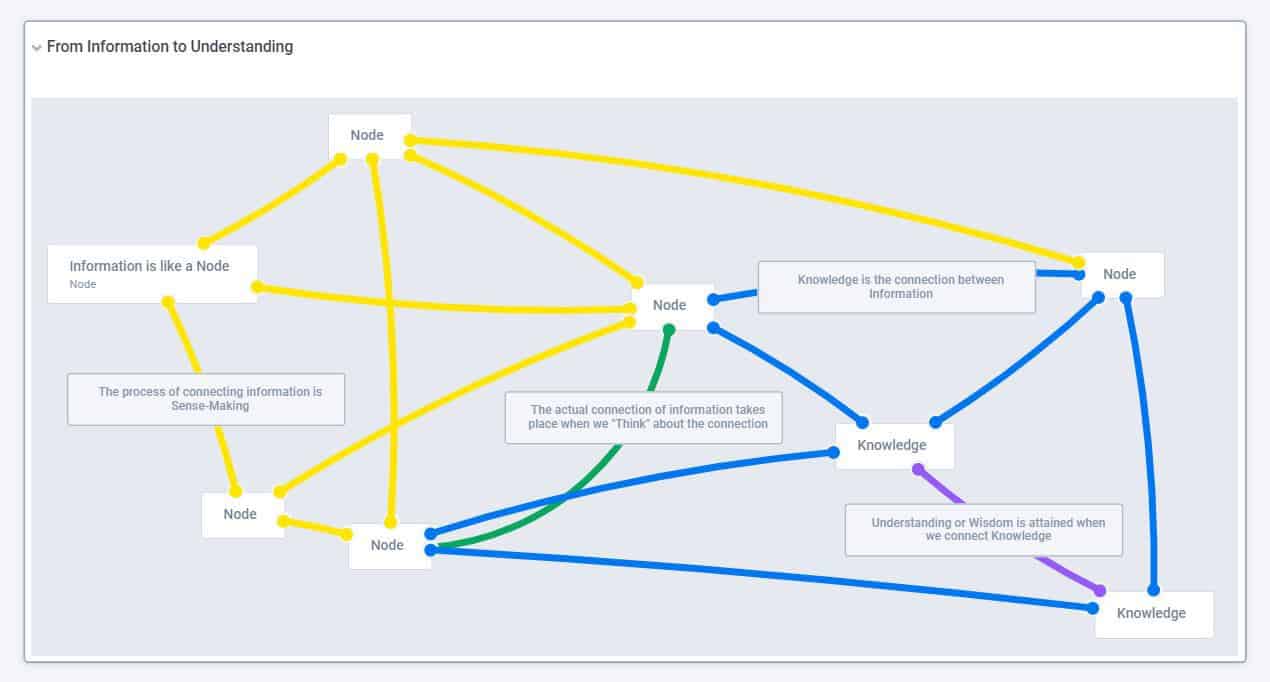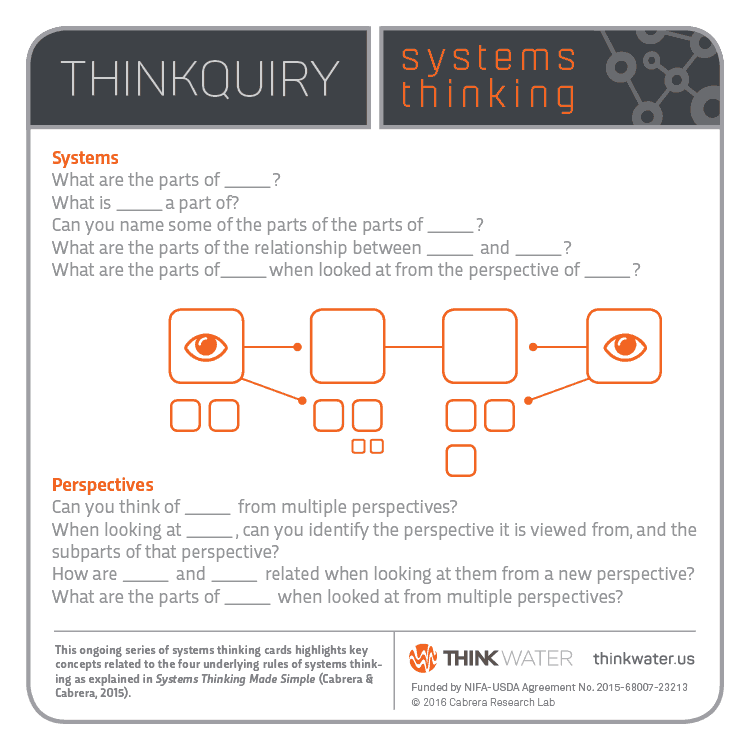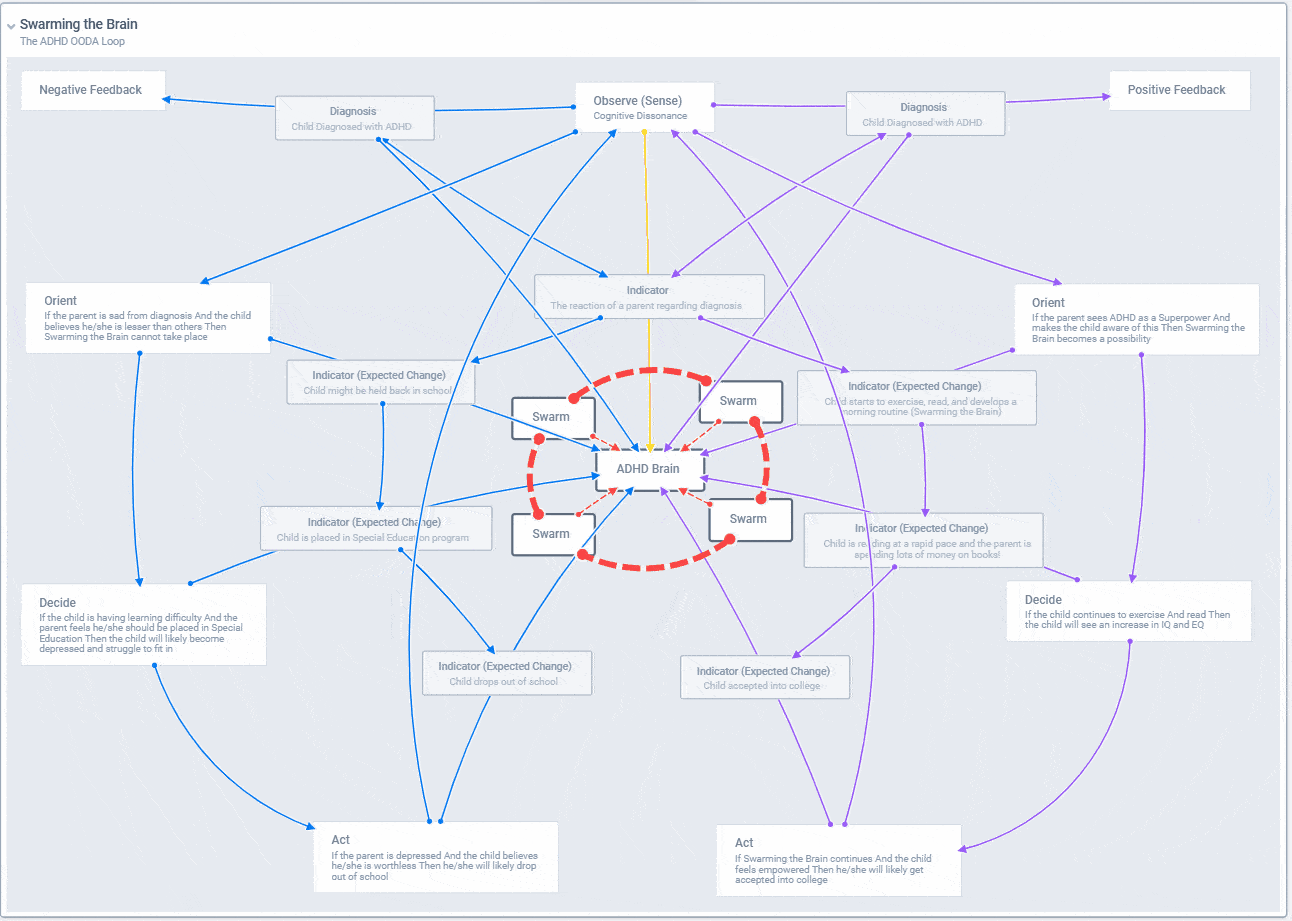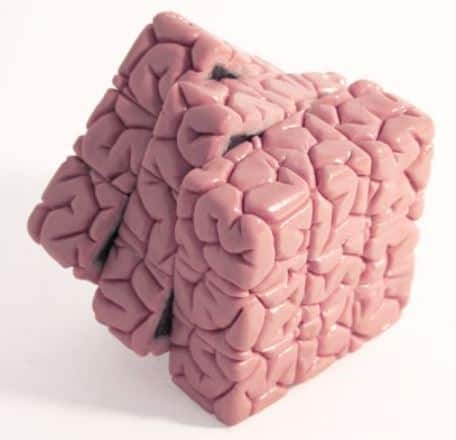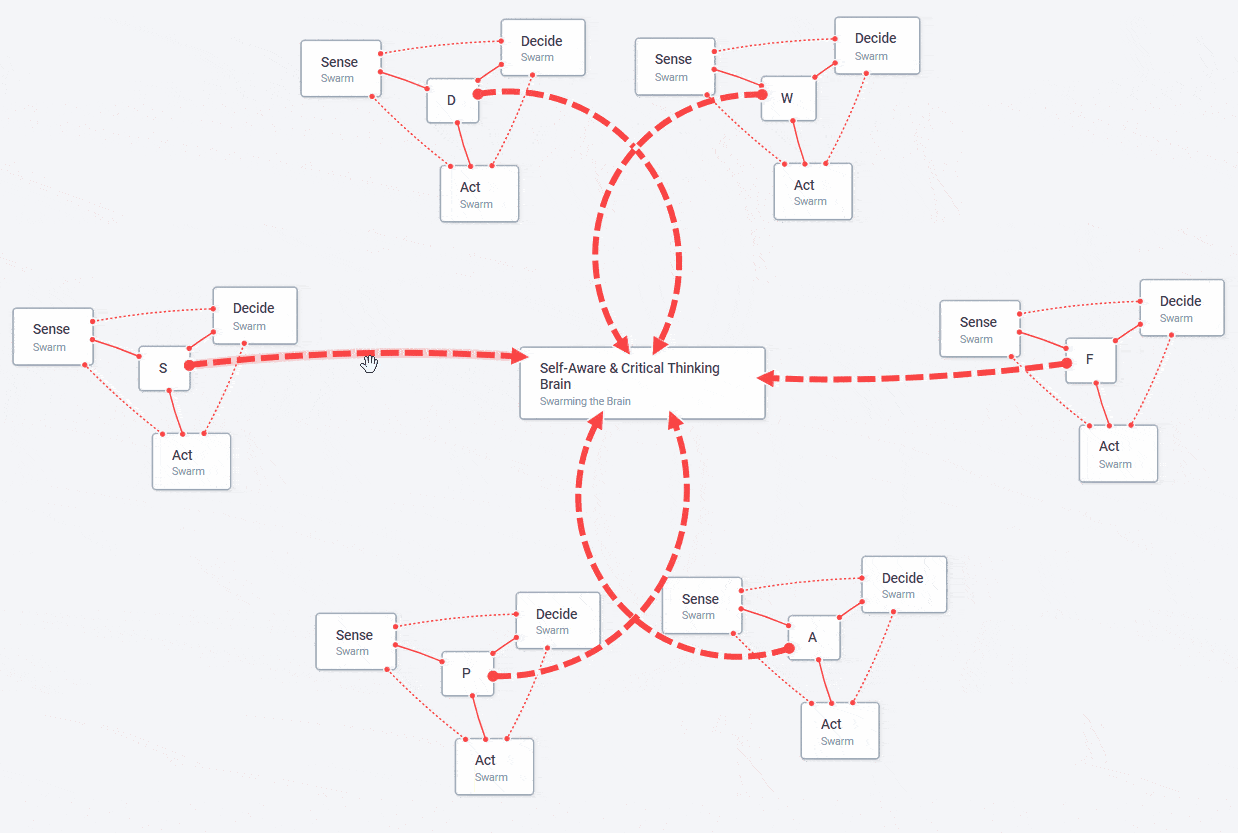My intent for this discussion is to build on an article I published called How to Upgrade Your Critical Thinking Skills for a Sharper Mind. The focus here will be on self-awareness, critical thinking and a new idea I am developing called “Swarming the Brain”.
I will use methods and frameworks from Systems Thinking V2.0, the Red Team Handbook from the Center for Applied Creative and Critical Thinking, and Colonel John Boyd’s OODA Loop. I will then demonstrate tools and techniques from these frameworks to show how you can improve your critical thinking abilities, as well as self-awareness.
Table of Contents
4 Simple rules for self-awareness
Similar to how I introduced How to Upgrade Your Critical Thinking Skills for a Sharper Mind, here I will introduce another version of it leading to greater self-awareness. In this version, there are four simple rules for self-awareness. These simple rules will move us from information to understanding.
Simple rules moving us from information to understanding:
- Observe. Sense information (think of nodes within a network).
- Orient. This is the process of making sense of the information (think of the process of connecting nodes within a network).
- Decide. Thinking is introduced to connect the nodes (the connection of nodes within a network is the creation of knowledge).
- Act. When we connect knowledge we attain understanding or wisdom (think of the emergence of a network or the edges of a network).
For each simple rule, I will provide both a question and a set of tools or frameworks to use.
The question should trigger the rule, where the tool or framework will lead to an emerging network. I use simple questions with simple rules because there is power in simple.
Sometimes the best way to get at the heart of the matter (especially in a complex world) is to ask a simple question:
Rule #1 — Observe: The Unexamined Life
Observe (Awareness or Awakening)
- Question: What lens do I see reality through?
- Tool(s): Systems Thinking V2.0 (DSRP) and Who Am I?
The process of improving self-awareness through introspection takes discipline to look inward to examine our own thoughts, feelings and motives. Self-awareness is the capacity for introspection, as well as the ability to be more enabled as a critical thinker and more aware of your own biases. It is through this understanding of the individual that an expanded world view opens.
By reflecting on our world view, we are essentially trying to understand our mental models. The Cabrera’s inform us,
“Mental models shape our understanding of everything around us. The goal of systems thinking is the continuous improvement and refinement of our mental models such that they more closely reflect the real world. The closer the mental model to reality, the more useful it is to us.”
The Cabrera’s discovered DSRP in order to interrogate our mental models. They remind us that our understanding of reality is just an approximation. Following the advice of the Cabrera’s, I used a combination of DSRP and a Red Team exercise to understand my own mental model.
One of the first techniques we learn in Red Team training (instructed by the UFMCS Center for Applied Critical Thinking) is an exercise called Who Am I? This exercise requires reflection and introspection of your personal narratives and dynamics, culture, religion, education, and critical watershed moments that shape your worldview and values. Let’s briefly examine the method for this exercise.
- Step 1. You must first recall seminal life changing events and moments that shape who you are. To do this you must conduct a disciplined self-reflection study of your life.
- Step 2. Share your Who Am I? in a group setting or with another individual. The people or person listening should not speak or interrupt you in any way. So find someone who is good at active listening and explain to them specifically what you need prior to beginning the exercise.
This is also a great team building exercise. You will find that you truly get to know each other on a deep level by simply conducting this exercise.
With that said, let’s a couple powerful tools offered by the Cabrera’s in Systems Thinking v2.0: Thinkquiry and Plectica.
Thinkquiry
Thinkquiry is the term the Cabrera’s use for thinking differently about how we ask questions from a systems thinking approach. What’s different about Thinkquiry is the underlying logic of DSRP which is multivalent. Traditional question logic is born of Socratic Logic (which is bivalent logic) and typically employs such rubrics as the 5Ws (Who, What, Where, When, Why).
DSRP Logic expands on this bivalent Logic which means that these kinds of questions can still be asked, but we are encouraged to penetrate deeper into our topic and ask deeper questions. [1] The following illustrates some of these questions:
Plectica
It is a visual systems mapping software based on Systems Thinking v2.0. I personally use this free software daily to visualize, analyze and synthesize concepts to gain a greater understanding of ideas or concepts in their entirety. The image below represents the creativity this system offers us as I used it to create my swarming idea.
I also recommend watching the following video for a deeper understanding of Systems Thinking V2.0 — DSRP:
By thinking meta-cognitively (thinking about thinking) we are able reshape connections in our brain and reshape our mental models. You actually reshaped connections in your brain by simply watching the Systems Thinking v2.0 video.
Rule #2 — Orient: Hang a question mark on things
Rule #2: Orient
- Question: What would have to exist for something to be true? Or why must something be true?
- Tool(s): Simple Rules and the String of Pearls (Think IF-AND-THEN)
In Flock Not Clock, the Cabrera’s provide an example of using simple rules leading to emergent behavior in an organization. This is a powerful technique and is the foundation for this entire article (as this article is essentially simple rule for an emergent behavior). Let’s see how this works.
Step 1: Identify your future state
Step 2: Identify simple rules
- Rule #1: Observe
- Rule #2: Orient
- Rule #3: Decide
- Rule #4: Act
Step 3: Emergent behavior (What can we actually see)
We learn to observe the real world via a new mental model, orient to reality, make good decisions, and most importantly… to act (while receiving and reflecting on continuous feedback).
The String of Pearls technique can be found in the Red Team Handbook. It is a way to ensure teams consider unintended consequences. It is a tool to help prevent “wishing” or “assuming away the problem” and to identify weaknesses in thinking or a plan.
Moreover, similar to the domains within Bloom’s Taxonomy, this technique uses domains. Bloom’s Taxonomy provides three domains: cognitive domain (reflects knowledge); affective domain (reflects emotion); physical domain (reflects the body). Let’s further examine these three domains:
- The Cognitive Domain: Reflects knowledge — the mind completes levels of understanding of a concept; building to the next higher level of understanding. To me, this is like visualizing the Rubik’s Cube as a brain.
- The Affective Domain: Reflects emotion — our attitude and awareness. We feel levels of emotion about recognizing and synthesizing information.
- The Physical Domain. Reflects the body — we connect mind (Cognitive Domain) to body events in a way that generates muscle memory for an action.
Events (also known as actions) are called 1st order effects and occur in the Physical Domain. 2nd order effects represent how we feel about the event (Affective Domain). 3rd order effects represent thoughts about the event (Cognitive Domain).
Furthermore, cascading effects follow a chain of actual causality (If-Then) as they occur in the Physical Domain — where one event precipitates the next. Events subsequent to 2nd and 3rd order effects which precede them are unintended consequences of the first event. However, they are not caused by the original event. By identifying unintended consequences, we can minimize the likelihood of overlooking something.
The following three questions are key to the String of Pearls technique:
- Will your plan or actions produce a cascade of other events? If so, what could they be?
- What message or information is being conveyed by the plan or action and to whom is it being conveyed?
- How will the message be interpreted by others?
Rule #3 — Decide: Crisis hunters
Rule #3: Decide
- Question: Where are the pattern of bullet holes NOT located?
- Tool(s): Scout Wheel
Nassim Taleb writes in Fooled by Randomness,
“In the markets, there is a category of traders who have inverse rare events, for whom volatility is often a bearer of good news. These traders lose money frequently, but in small amounts, and make money rarely, but in large amounts. I call them crisis hunters. I am happy to be one of them.”
Taleb goes on to inform us of an asymmetry in knowledge. In his discussion on why statisticians don’t detect rare events, he provides the following example,
“Common statistical method is based on the steady augmentation of the confidence level, in nonlinear proportion to the number of observations. That is, for an n times increase in the sample size, we increase our knowledge by the square root of n. Suppose I am drawing from an urn containing red and black balls. My confidence level about the relative proportion of red and black balls, after 20 drawings is not twice the one I have after 10 drawings; it is merely multiplied by the square root of 2 (that is, 1.41).”
Taleb continue with the following remarks,
“Where statistics becomes complicated, and fails us, is when we have distributions that are not symmetric, like the urn above. If there is a very small probability of finding a red ball in an urn dominated by black ones, then our knowledge about the absence of red balls will increase very slowly — more slowly than at the expected square root of n rate.”
Here is a key point in his discussion,
“On the other hand our knowledge of the presence of red balls will dramatically improve once one of them is found. This asymmetry of knowledge is not trivial.”
What does this mean?
What if red balls were randomly distributed as well? As Taleb informs us that we can never get a true composition of the urn. He provides an example of an urn with a hollow bottom, and as you are sampling from it, a mischievous child (without you knowing about it) is adding balls of one color or another.
Taleb remarks,
“My inference thus becomes insignificant. I may infer that the red balls represent 50% of the urn while the mischievous child, hearing me, would swiftly replace all the red balls with black ones. This makes much of our knowledge derived through statistics quite shaky.”
So, what’s the point?
Taleb points out that we take past history as a single homogeneous sample believing we have significantly increased our knowledge of the future by observing the sample of the past.
Taleb asks two questions at the end of his example:
- What if vicious children were changing the composition of the urn
- In other words, what if things have changed?
The point of this discussion is that things do in fact change. As self-aware critical thinkers, we should not be worried about increasing our knowledge about the absence of red balls… we should seek to improve our knowledge of the presence of red balls. Thus, we should never forget that things will change.
This brings me back to my earlier discussion on changing how we phrase a question. A simple change in how we phrase a question allows us to completely change our perspective and potentially bring about a paradigm shift. The change here is the following:
Change “absence” of red balls to “presence” of red balls. Thus, you seek to become a crisis hunter — an asymmetry in knowledge.
For those of you who are a fan of Sherlock Holmes and have read How to Upgrade Your Critical Thinking Skills for a Sharper Mind, go back and read my section titled SDWFAP.
- Scouting (S): Think like a Scout — the drive to see what’s really there.
- Dog (D): Find the Dog who isn’t barking.
- Was (W): What would have to exist for something to be true?
- Frightened (F): What’s not right in Front of us?
- At (A): Ask what evidence is not being seen, but would be expected for hypothesis to be true.
- Patterns (P): Where are the Pattern (or location) of bullet holes NOT located?
Moreover, we can visualize using SDWFAP to swarm our brain. Using simple rules similar to how Artificial Intelligence (AI) would using swarming tactics: Sense — Decide — Act. Let’s see how we could “Swarm the Self-Aware & Critical Thinking Brain”:
Rule #4 — Act: Success = Sensors + Feedback
Rule #4: Act
- Question: Where is the dog who isn’t barking?
- Tool(s): Swarming the Brain Tactics
If we change our behavior we change our brain. “Swarming the Brain” is priming the brain to learn and we can do this through the development of sensors (or triggers), exercise, nutrition, reading and learning, the development of a morning routine, and receiving (and reflecting on) continuous positive feedback. We must also identify key indicators of change. These allow us the ability to assess change and the ability to place key sensors in the form of Indicators (or Expected Change).
Moreover, the first rule is the most crucial — Observe. Let’s examine this from a parent-child relationship. If the parent is not aware then the child will not be aware. This is why something must serve as the sensor or trigger to bring about awareness.
This reminds me of how I use my favorite iOS application — WikiLinks Smart Wikipedia Reader. This app mimics the way I think as it maps and connects concepts and narratives.
For example, if we are only aware of the term ADHD as a diagnosis of a Disorder, then we will not be aware of any additional knowledge. But if we are aware of additional knowledge, and aware to the fact that ADHD is not a Disorder, then we start to see more links, then more links, then a paradigm shift takes place.
Here, a parent must first shift their perspective from,
“If my child is diagnosed with ADHD — And it’s a Disorder — Then my child will receive Negative Feedback.” to “If my child is diagnosed with ADHD — And it’s a Superpower — Then my child will receive Positive Feedback.”
Once the shift takes place, they should establish Indicators (Expected Change) and set the conditions so that the swarm can proceed.
The following are what I call Swarming the Brain Tactics:
- Exercise and Nutrition: Dr. John Ratey wrote about one of my favorite topics — Neurogenesis in one of my favorite books Spark: The Revolutionary New Science of Exercise and the Brain. He found that, as we age, our brain is still forming new brain cells and can change its structure and function.
- Reading and Learning: Through reading and learning, we can reshape our brain as it brings in new challenges and keeps the child cognitively active.
- Morning Routine: Establishing a morning routine allows a child (and you!) the ability to wake up before anyone else, kick start your metabolism, and provides you time to read and exercise (I do them together by listening to audio-books).
Finally, we all have the ability to improve our self-awareness. If we follow the simple rules outlined in this discussion, we have the chance to improve and become better (more self-aware) critical thinkers. Thus, we have a chance to bring about an intelligent emergent behavior.
“People often do not realize that they have a chance, so they miss it.” — Nassim Nicholas Taleb
Recommended readings to help you understand more
To learn more about these methods/frameworks, I recommend you read the following:
- Swarming the Brain: The ADHD OODA Loop. I discuss this topic in greater detail.
- How to Upgrade Your Critical Thinking Skills for a Sharper Mind. I discuss each framework in this article.
- Systems Thinking v2.0. Dr. Derek and Laura Cabrera discuss simple rules of systems thinking — Distinctions-Systems-Relationships-Perspectives (DSRP) in two books I highly recommend: Systems Thinking Made Simple and Flock Not Clock. I also recommend using Plectica — their free visual systems mapping software based on Systems Thinking V2.0. Nearly every image I use in this article was created using Plectica.
- The University of Foreign Military and Cultural Studies (UFMCS) Center for Applied Creative and Critical Thinking. I highly recommend reading the free Red Team Handbook published by the UFMCS.
- Colonel John Boyd’s OODA Loop. Frans P.B. Osinga provides the most in-depth description and understanding of the OODA Loop in Science, Strategy and War: The Strategic Theory of John Boyd. I also highly recommend reading The Tao of Boyd: How to Master the OODA Loop.
Featured photo credit: Pexels via pexels.com
Reference
| [1] | ^ | Thinkquiry.us |

